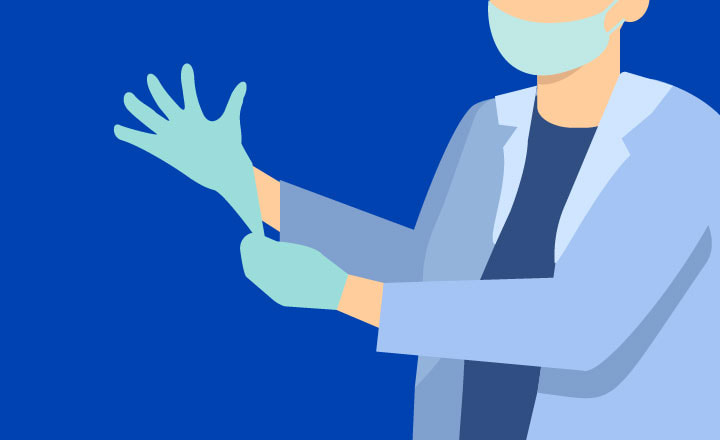|
By: Hannah Lin (CC '23)
Could you describe your COVID-19 research at the moment? I’m an immunologist, and we work on immune responses to respiratory viruses. We’ve actually been studying this topic for a long time mostly in mouse models and influenza, and we also have a big interest in the human immune response, particularly in tissue sites such as the lung and other mucosal sites. So it was not a big departure to take on a COVID research project because we study respiratory immunity in humans already. For infections that infect particular tissue sites, such as the lung, we know that there are specialized immune cells that are resident in the lung, and these lung resident immune cells - rather than immune cells circulating in the blood - are really important for protection against respiratory pathogens. So we were very interested in what might be going on in the lungs in patients with COVID-19 that are trying to mount an immune response against respiratory infection with SARS-CoV-2.
distress syndrome, and they need to be intubated and receive supportive care on a mechanical ventilator. When the babies have a tube in their throat, this tube is flushed out a few times a day with saline, to unclog the tube from secretions. So usually the nurses will clean out the tube and then take the wash to throw it away. We reasoned this could be a good way to get a respiratory sampling of a patient, and since it’s done everyday, we can follow the course of the immune response in the respiratory environment in these patients by taking that wash. So that’s what we’ve been doing for the last 7 years. There’s a pediatric clinician-scientist at my lab, Tom Connors, who has been working on this project for a while now. What we found is that getting the washes from those tubes gives you a nice view into the respiratory environment, and you can see different immune cells coming in, getting activated, you can pick out innate cells, like monocytes and neutrophils, as well as lymphocytes, such as T-cells. And T-cells are a major component of antiviral immunity in the lung. These are the cells that are going to clear the virally infected cell and stop and halt the progression of infection. In fact, you’re able to follow that T-cells came in and that their numbers and frequencies increased, and that they correlated with both protection as well as with a sort of disease severity.
We have an IRB where we get respiratory washes each day from intubated COVID-19 patients—these are patients who have severe disease from SARS-CoV-2 infection. They are intubated; they’re in the medical ICU or, a couple weeks ago, there were ICUs all over the hospital, so there were all these pop-up ICUs because there were so many patients who needed supportive care because they were experiencing what’s called ARDS, or acute respiratory distress syndrome, from SARS-CoV-2 infection. So we have an IRB where we get these respiratory samples but also paired blood samples so we can look at the immune cells in the respiratory environment as well as the systemic immune response and see if we have some immune correlate of either protection or disease severity. So we’re following these patients—both their immune phenotype as well as their viral load. And we can also capture all the important clinical data on these patients. We’ve enrolled 25 patients so far, of all different ages, and these include a lot of different outcomes. So these are people who have died, people who have recovered, and then we were also actually able to capture a small cohort of patients with this pediatric inflammatory syndrome that you might have read about recently, because it just captured everybody in the different ICUs. What we’re doing with these respiratory and blood samples is very detailed profiling of the different immune cells in these samples so we can follow how immune cells change over time. That’s what we’re putting together now. With the clinical data, we can see if there are other changes that correlate with a certain progression of clinical course or recovery. So that’s one of the main things that we’re doing in our COVID research, and it relates to questions that we’re asking in our ongoing research before COVID. Rewinding a little, what are IRBs? An IRB is a human subjects protocol. So, institutional review board is why they’re called IRB. Basically, to do any work with human subjects, you have to get a protocol approved by an institutional committee. This ensures that everything you’re doing with the patients is properly consented, that proper care and safety procedures are followed, and that the protected health information is limited to only the people who are doing the study. So for any kind of human subjects, you need to have these protocols. Got it. How has your research progress been? Have you had any setbacks?
Additional safety procedures are followed. We have more PPE for the people doing this. It’s been challenging also because we’re processing this in teams of two people, so we’re minimizing the number of people who can work on it, but it’s better to have two rather than one, just to make it more efficient. It’s a very different way of doing lab work, where we have teams that are coming in on different days. We’ve coordinated with our wonderful clinical collaborators in the critical care division in the Department of Medicine. Dr. Matthew Baldwin is consenting all the ICU patients on the adult side, Dr. Tom Connors on the pediatric side. The samples are very challenging because the ICU patients are very, very sick and the quality of the sample varies. We’ve had to optimize and develop different ways to purify the cells from the samples to make sure we’re getting really good viability and that these are useful. There have been a lot of optimizing as we go along, just because of the nature of the work—there’s a timeliness to it. The number of patients has gone down now. We peaked in May, but now the number of patients has gone down, which is a good thing. You’ve been in the immunology field for a long time--has there been anything in the past few months in your COVID research that has really surprised you? Well, we’re still analyzing all the data. We’ve also done a study just with some other people here, with antibodies, so I think that’s not so straightforward—the kind of antibody response and how that correlates with disease. The remarkable part of our results is seeing just how many changes there are in these immune cells, and how many different things are going on in terms of immune activation—that these patients seem to have a very significant immune response that’s quite diverse, that’s quite potent. And we have to figure out what parts of that immune response are actually causing the damage and the disease and what parts are trying to protect against the virus. That’s going to be the real challenge. So you said the transition from your prior research to this COVID-19 research was pretty smooth because it was in your realm. Is your team still keeping prior projects going while this COVID-19 research is going on? They are in terms of writing up things, writing up papers, doing data analysis. So a lot of our research involves transcriptional data, like RNA sequencing, single-cell data. So that analysis is still going on. People are writing up graduate school qualifying exams, we have a thesis defense next week, so we had a senior student writing up his thesis. We’ve submitted some papers, doing that sort of thing. And we’ve kept the mouse colonies going and some limited work with that. We’re ramping that up now, because we have these mouse flu models, so it’s completely relevant and we’re trying to set that up now so we can finish some experiments for some papers. But all of our human work that is not COVID-related had to be shut down, put on pause. So we’re working on trying to get that up again in the next few weeks. Are there any common misconceptions you’ve heard about COVID-19 that you’d like to rectify or respond to? There’s just so much out there so quickly that it’s really dizzying. Like what’s the latest with this and what’s the latest with that? I think the most is just the antibody response and whether that indicates protection, what that really means, how soon will the vaccine be out there. I think those are really important questions that there’s been a lot of speculation about and a lot of theories, and I think none of us have the answer. But I think you can’t assume anything. If you have the antibody, you might feel protected, but I think what you can assume is that if you’ve had an illness and it isn’t a very bad illness—with COVID, let’s say you weren’t hospitalized, even though it’s quite terrible, what I’ve heard of people who have become infected. It’s quite a long and harrowing illness. But if you’re not hospitalized and you get better, that’s a really good outcome. It seems like those people are probably protected, I would say, just based on what we know about viruses and the fact that they have antibodies. And they have T-cell responses—we know that now from some early work, from studies in California. So they may be protected, but we don’t know. We’re still not sure. Last question: what is your perspective on the future, both regarding your own research and the broader impacts of COVID-19? I think it’s going to change in the short term just the way we do research. I think we’re not going to have full lab meetings, do a lot of Zoom things; when we have to write, we’ll have to be out of the lab. I think that’s okay, I think we’ll adjust to that.
COVID related and what isn’t. Speaking more on the medical center since that’s what I’m most familiar with, but also on the other campuses, really all basic, fundamental biomedical research.
So I think we need to get back and do it in a way that’s going to be safe by having shifts, by using protection, personal protective masks, whatever we need to do so that we can get back, because I think this work that everybody is doing here is really essential, whether we’re working on COVID patients or not. COVID patient numbers are really going down now, and now we really have to prepare for this next phase. And the next phase is how do we do research in the midst of a pandemic, because it’s important that we do that, that we’re here, that we have this presence, that all biomedical research can progress. We’re starting right now, and we’ll see how it goes, and then we’ll just continue with all these precautions and we hope that works. I think one of the things that lends itself in the laboratory is the small groups. These small groups of people—we collaborate with other labs, but you don’t need to see them everyday. In the lab group, you can divide them into smaller teams, and people will just be with their teams. This is something we can do, that you don’t need a big crowd for. We can change it in a way that will keep us safe. But I think the nature of laboratory work requires that you’re here on site. But also, it allows for small groups and individual people to work by themselves. So I think we need to take advantage of that and try to be productive within the other constraints of being in a pandemic.
0 Comments
Your comment will be posted after it is approved.
Leave a Reply. |





